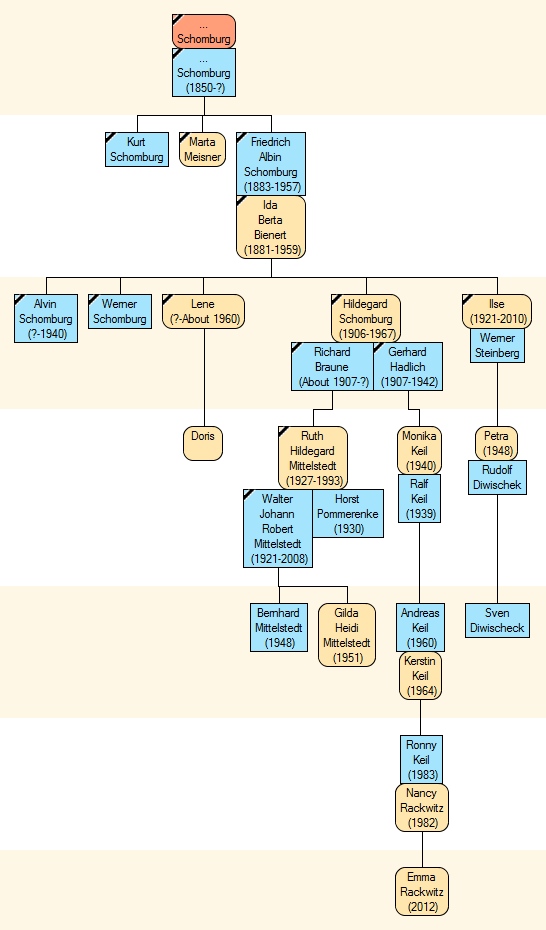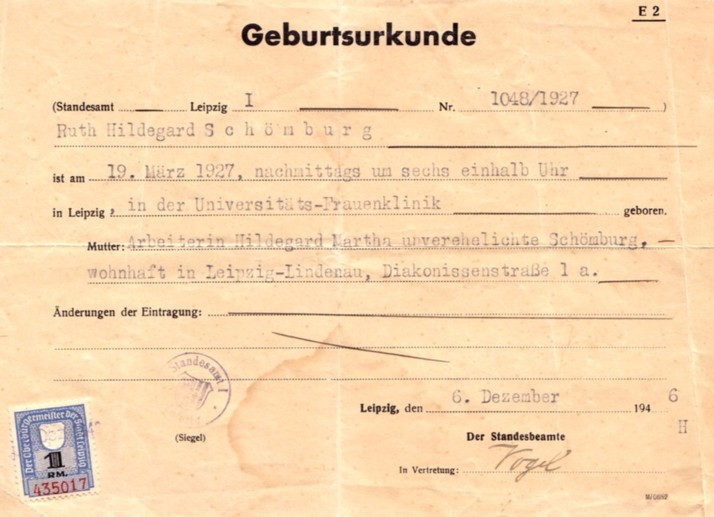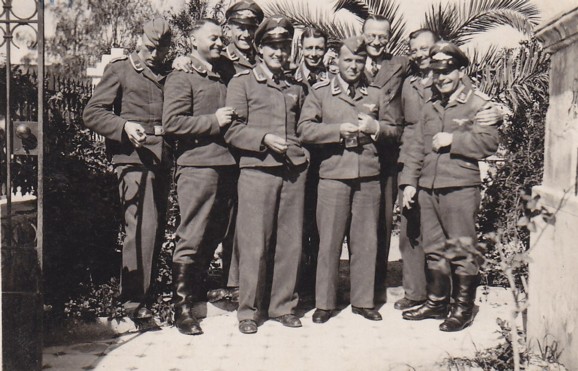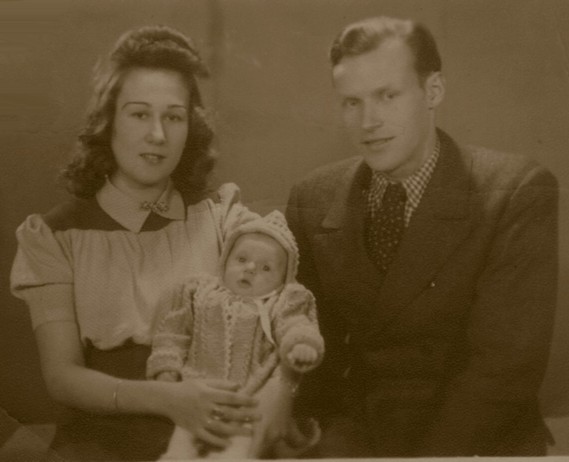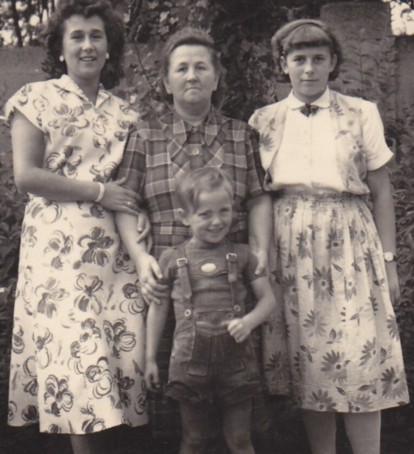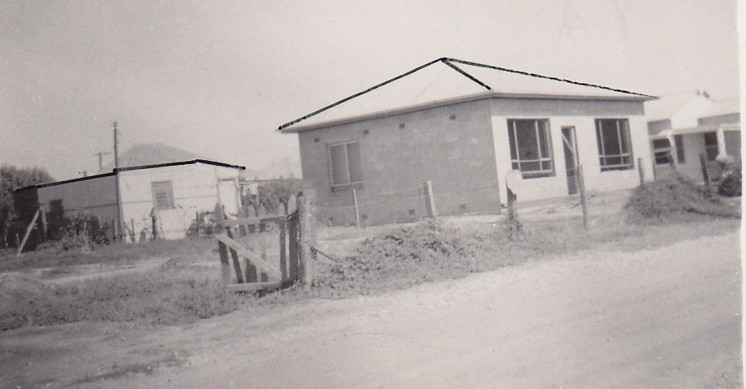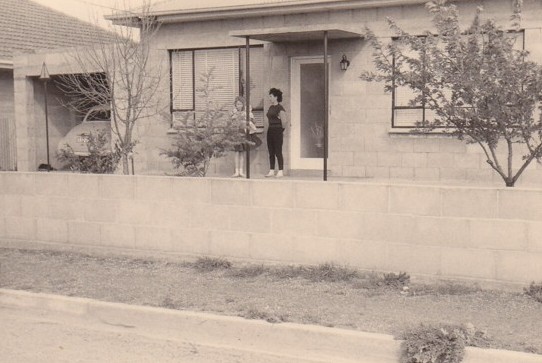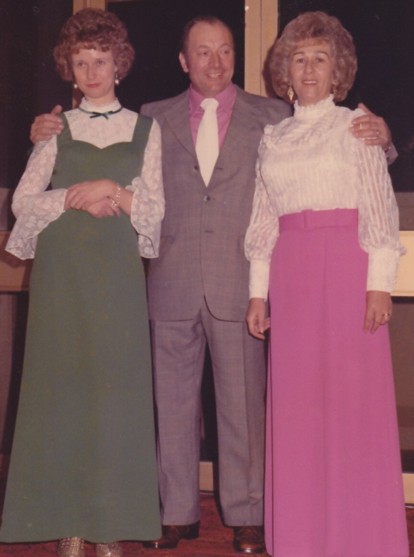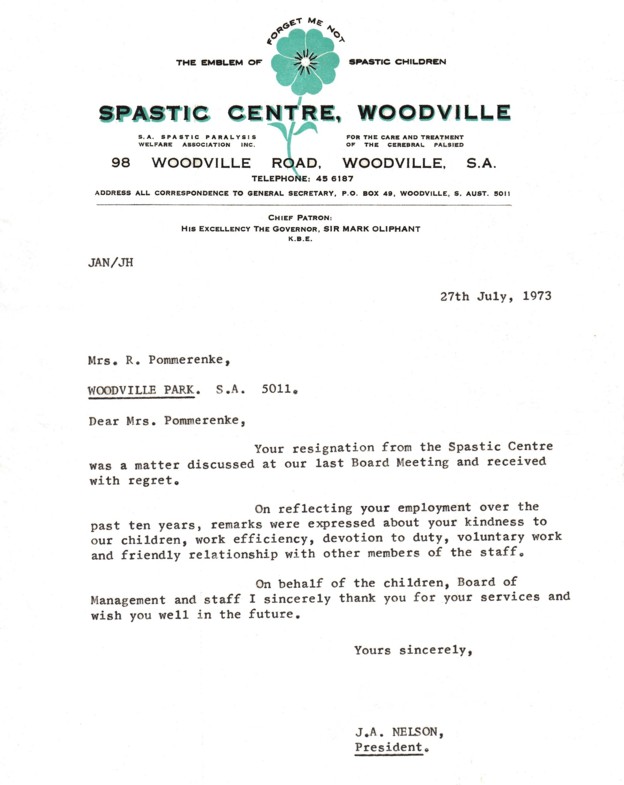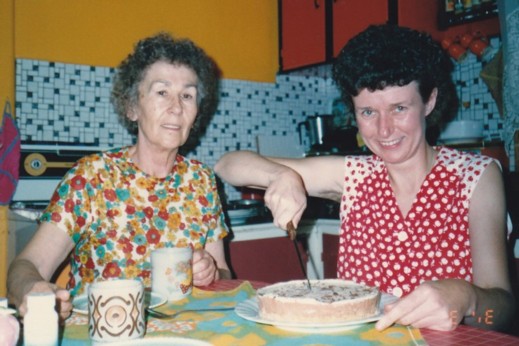RUTH HILDEGARD SCHOMBURG/MITTELSTEDT (1927-1993)
This website is about people with a "Mittelstedt" father, but I make an exception for my mother, Ruth Hildegard SchÖmburg
["Schoemburg"].
SCHOMBURG FAMILY
The "Schomburg" at the top of the above chart was a farmer at Insterburg (Chernyakhovsk), East Prussia.
His son, Friedrich Albin Schomburg (September 1883 - 1957), moved to Leipzig where in 1905 he married Ida Berta Bienert (August 14, 1881 - November 14, 1959). They had five children.
Their daughter Hildegard Martha (1906-1967) did sewing in the textile industry. Hildegard had her first daughter, Ruth Hildegard, in 1927 with Richard Braune (occupation - goldsmith) but they did not marry.
Hildegard married Gerhard Hadlich and they had a daughter, Monika, in 1940. Gerhard Hadlich was in the Germany army (Wehrmacht) and died at Stalingrad on December 31, 1942. Hildegard's brother Alvin was also in the Wehrmacht and died in Poland in 1940. The other brother, Werner, was convicted of murdering a woman and was executed in the early 1940s. Her sister Ilse lost a finger in a munitions factory in 1943 and a baby daughter from diptheria in 1945.
Hildegard remained unmarried after Gerhard died, lived the rest of her life in Leipzig, and got liver cancer after 1960.
Albin and Ida Schomburg on their 50th wedding anniversary in August 1955
RUTH HILDEGARD
Ruth Hildegard lived with her grandparents Albin and Ida until 1940 and then with her mother until 1946. Albin had a cottage in the countryside where Ruth could help herself on wild berries, strawberries and other fruit. She recalled sometimes joining her grandfather when he went fishing and how one day a large fish pulled him into the river. Another time when aged ten she was kept in after school by the female teacher who then forgot about her and locked the classroom. It was 2 a.m. when Albin along with the police arrived and took her home.
In this early part of her life Ruth apparently lived in the suburb Knauthain to the south of Leipzig. In 1940, at the start of World War II, she moved in with her mother and sister at 1a Diakonissen Strasse in the suburb Lindenau. She remembered often going hungry, or eating only a porridge made from a single grated potato boiled in water, and often being left alone to look after her sister Monika.
Ruth said their apartment was damaged by Allied bombs and repaired and later almost destroyed. This destruction may have occurred on February 20, 1944 when 1,000 U.S. bombers struck Leipzig and Brunswick. The family then moved to 6 Odermann Strasse.
Ruth's education was limited to primary school. She worked as a salesgirl in a store (possibly named "Hells") in 1942, was bedridden several months in 1943 with diptheria, then worked as a typiste in the office section of a "Stahlfeder Fabrik" (factory making steel springs) where she typed the wages accounts (Lohnbuch haltung). She remembered a kindly boss named Fritz Winkler, and a teenage co-worker named Julia who was Jewish and was one day escorted out of the office by the Gestapo and never returned.
Apparently Ruth had some boyfriends at this time. On one photo dated October 1941 a young soldier wrote "Yours alone", and on another photo dated August 1943 a young man wrote "In Liebe" i.e. "With love".
The following photo, dated December 24 1943, shows a group of Luftwaffe ground-workers:
Words on the reverse side express appreciation: "unserem netten stopp der Ruth zur Erinnerung an schÖne Stunden gewidmed im Fliegerhorst Brandis." In English possibly: "Our pleasant stop [from work], in remembrance of Ruth for lovely hours devoted in military airfield Brandis."
[Brandis airfield, 15km east of central Leipzig, was built in 1934-1935 and used for testing aircraft. In July 1944 Brandis became the home airfield for the Messerschmitt ME 163 rocket fighter. The USA Air Force bombed Brandis in 1944 and 1945 and the US Army captured it on April 17, 1945 and handed it to Soviet control on July 2. The airfield was closed in 2005 and became a solar energy plant.]
Given the date (Christmas) and Ruth's age at the time (16), her visit to Brandis was probably as a duty for the Bund Deutscher Maedel, the Nazi youth organization for girls. Ruth never mentioned membership in the BDM, but social visits to military airfields and hospitals and troops on leave were among standard BDM duties. Membership for all German girls up to the age of 18 became compulsory in 1939.
U.S. troops occupied Leipzig on April 19 1945. When they withdrew in July to be replaced by Russian forces the War in Europe was over and therefore, said Ruth, she was never molested or raped.
In December 1945 Ruth experienced a brief unconsummated marriage to a Gerhard Lehmann. The marriage was urged on her by her mother in the hope that Gerhard's contacts would lead to getting more food. Immediately after the wedding, however, he was arrested for political activities. Gerhard was released for three days, then re-arrested. She never saw him again and the marriage was annulled. Ruth never said more about Gerhard than the above. Her divorce petition (September 1965) to end her second marriage states: "The surname of the petitioner immediately before the marriage was Lehmann. The petitioner went through a ceremony of marriage on the 25th day of December 1945 which marriage was annulled by a court having jurisdiction in East Germany in the month of January 1946."
In 1946 Ruth was courted by a Russian officer who wanted to marry her and take her to Russia. Instead, with a group of other people, she fled across the border one night in 1947. Two of the group did not make it — they were shot by border guards.
Ruth went to Hamburg because a sister of her grandfather lived there, and found employment at Philips Electronics.
[Philips was a Dutch multinational company founded in 1891 which manufactured electrical components and appliances. Deutsche Philips was founded in Berlin 1926 and moved its main offices and administration to Hamburg in 1946. In 2012 Philips employed 120,000 people in 60 countries]
The female workers lived in dormitories and had parties on Saturdays. That's how Ruth met Walter Mittelstedt when, one Saturday, he attended.
In 1948 they lived in a one room apartment in the Hamburg suburb Eidelstedt (Reichsbahnstrasse). Walter was unemployed but earned income by repairing radios. Their son was born in October 1948 and daughter, Gilda, in November 1951.
1948 December 24. Ruth with Walter and son
1954 April. Ruth (left) with her mother Hildegard and sister Monika in Leipzig
In mid 1953 Ruth and Walter moved to better accommodation in the suburb Eimsbuettel (Eidelstedterweg 102b). There they had a bedroom, loungeroom, kitchen and bathroom.
In 1952 Ruth went to Leipzig and met her father, Richard Braune, for the first and only time. She made another visit to Leipzig in April 1954 taking her children to see her mother and sister.
The following month Walter and Ruth Mittelstedt and children left Germany for Australia on the ship Anna Salen and arrived in Melbourne on July 2.
[Anna Salen News; Departure]
They spent mid-winter in Bonegilla migrant hostel in Victoria; then Woodside migrant hostel in South Australia; then a few months in a rented house in the Adelaide suburb of Hindmarsh (Queen Street).
[Bonegilla, near Albury near the border of NSW, was Australia's largest migrant reception centre. From 1947 to 1971 it received 300,000 people, about half of all immigrants from Europe.
Woodside is in the Adelaide Hills about 27km east of Adelaide's CBD. The area was first settled by Germans in the 1840s. In the 1940s and 1950s it hosted a hostel for migrants from Europe.
Hindmarsh is the first suburb NW of Adelaide's CBD.]
The first photo of Ruth and her daughter in South Australia. The location is Queen Street, Hindmarsh, where the family lived in a rented house September 1954 to January 1955
In 1955 the family lived for about 10 months in a rented room in the suburb Mansfield Park (Richard Street). During 1955 Walter built a three-room wooden house in the neighboring suburb Wingfield (Fourth Street). The foundation for a brick house was laid that same year and the house completed in 1960.
The wooden house and brick house in 1959
Ruth had several temporary jobs serving customers in shops. Then, commencing in 1963 she worked for the Spastic Centre five half-days per week as a driver and nurse assistant. That same year Walter returned to Germany but came to Australia in 1965 to start divorce proceedings and then left again for Germany where he re-married.
c.1963. Ruth outside her house in Wingfield with her daughter
In the 1960s Ruth could look back with satisfaction over her achievements — from malnourishment in the 1940s to car-owner, house-owner, proficiency in a new language, and employment she enjoyed.
In 1969 she re-married — the new husband was another German immigrant, Horst Pommerenke. Ruth sold her house but the marriage then developed problems and she began to think about leaving. Her attempt to buy another house was defeated by sudden increases in real-estate prices with the 1970s oil crisis. This together with a car accident, hysterectomy and bowel cancer delayed the separation until 1979. After the divorce was finalized in 1981 Ruth invested in blocks of land and realized a profit, but with declining health the purchase of another house lost priority.
1973. Ruth (right) with husband Horst Pommerenke and daughter Gilda
Letter from the Spastic Centre upon Ruth's resignation
Ruth's daughter Gilda was "mentally retarded" possibly caused by meningitis in infancy. Gilda attended institutions, special schools, and workshops for the intellectually handicapped. She had behavioural problems which created stress and conflict for decades.
In the 1980s Gilda learned to play chess and for a while attended a chess club, and then began to learn to read and write. These events, along with church attendance gradually led to improved behaviour. Gilda took on more of the housework during the 1980s as Ruth slowed down due to sciatica, and more again in 1993 when Ruth had lung cancer.
1989 November. Ruth with daughter on the latter's birthday
